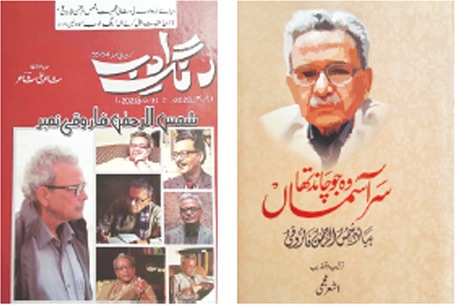
AFTER Shamsur Rahman Faruqi’s death on Dec 25, 2020, condolences and tributes flooded the online media, as was expected.
The print media, too, seemed in a shock and in fact the entire world of Urdu literature was in mourning. Some Urdu literary magazines and a few newspapers’ literary pages managed to publish hurriedly-assembled special sections on him within a short span of time.
It can be safely assumed that soon some more journals would come out with special issues on Faruqi. Books on him must be on their way, too. But as firsts, two full-length publications paying rich tributes to Faruqi have appeared. Looking at their thickness, it seems quite an achievement as it hardly took them a few months to produce something that can be referred to in the future for academic purposes besides paying tribute to and remembering the literary icon that helped define Urdu literature of his times.
Shamsur Rahman Faruqi had in fact become a part of Urdu’s literary cannon in his lifetime, be it his criticism, short stories, novels, literary theories, commentaries, translations, poetry, linguistic research, lexicographic works, prosodic acumen or his literary journal Shabkhoon, he was acknowledged as a maestro. There are few among his peers who can match him and still fewer among his juniors who could emulate him.
Though he could not remain unscathed by the inevitable controversies and rivalries, as is the tradition in the field of Urdu literature, Faruqi was looked at with awe and veneration. But the road to this glory was not all roses. He had to pick the thorns strewn all along the way, the treacherous road of literary theory and ‘ilm-i-bayan’ (exposition) that he had chosen for his long literary journey that spanned over six decades.
So paying tributes to this literary colossus was due and the two publications that have come out from Karachi have made us feel that we have been able to at least record our tributes to the personality Urdu literature and language were deeply indebted to.
The first one is the October 2020-March 2021 issue of Rang-i-Adab, a literary magazine published from Karachi. Edited by Shaer Ali Shaer, it is a large-size, 800-page, hardbound tome. The first section includes critical and impressionistic writings on Faruqi by some well-known, and some not-so-well-known, writers and critics. More than half the issue carries Faruqi’s works that include his letters, critical and linguistic as well as prosodic essays, his selected poetry, translations, and prose and poetry composed for children. It is something to refer to and relish.
Rang-i-Adab is a Pakistani publication, but a book compiled and edited by Ash’er Najmi and published in India has been reproduced in Pakistan too, with permission, of course. Titled Wo Jo Chaand Tha Sar-i-Aasmaan and published by Karachi’s City
Book Point, the 700-page book includes some very important autobiographical pieces by Faruqi as well as some of his critical articles. It also carries some interviews with Faruqi that increase the understanding of Faruqi’s point of view on different literary issues.
Ash’er Najmi had been very close to Shamsur Rahman Faruqi. Faruqi had played a pivotal role in success of Najmi’s Esbaat, an Urdu literary quarterly launched from Mumbai in 2008. Faruqi not only guided but also morally supported Najmi in this venture, which seemed like a bad decision at the outset as Urdu literary magazines were already losing market and interest of the readers fast, both in India and Pakistan. But Najmi successfully carved out a place for himself and his magazine in literary world.
Unfortunately, jealousies and rampant behind-the-scene literary politics caused to sour the association between the two. Faruqi was displeased and Najmi was disillusioned. The ties between the two were snapped and then Esbaat closed down, though only to be launched again. Years later, when Najmi heard that Faruqi was suffering from Covid-19, he resumed the ties by contacting Faruqi by phone, who responded in his usual frank style. So the friendship seemed to restart, but it
was not to be and Faruqi bid this mundane world farewell for his heavenly abode.
Najmi has sentimentally described how his love of reading led him to Faruqi’s works and how he fell deeply in love with Faruqi. As a bonus, after reading Najmi’s 150-page impressions titled Ye Lauh-i-Mazar To Meri Hai (This tombstone is mine), the readers come to comprehend India’s literary scene, literary groups and their rivalries during the last few decades or so, especially the literary feuds between Gopi Chand Narang and Shamsur Rahman Faruqi.
These two publications are absolutely must-reads for anyone who wants to carry out research or write on Faruqi or someone who just wants to have an idea what great contributions this literary giant has made.
Published in Dawn, July 26th, 2021














































Dear visitor, the comments section is undergoing an overhaul and will return soon.